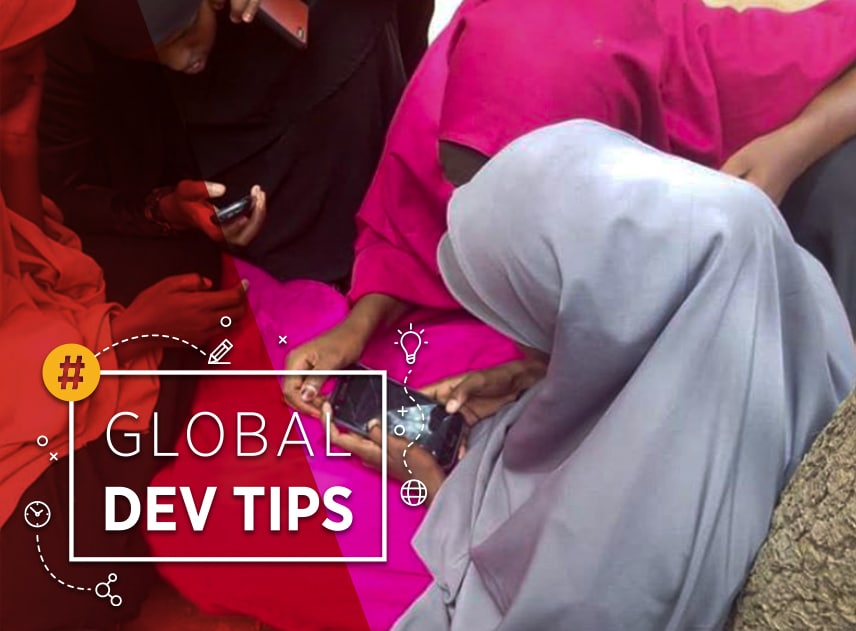
#GlobalDevTips: 4 Tips for Implementing EdTech in Development Programs
By: Muneeb Khan, Education Manager, WUSC
Innovations in technology are rapidly disrupting industries across sectors, from ride-hailing mobile apps, such as Uber, challenging traditional taxi services, to digital stores creating new competition for brick and mortar outlets.
The education industry is no exception; it is also in a state of digital transformation. Learning apps, such as Duolingo, Edmodo, and Google Classroom – together boasting over 350 million users – are being used widely for education by audiences across the world. Using these education technology (EdTEch) platforms, learners can access content at their own pace, tailored to their personal needs, and no longer controlled by one person standing at the front of the classroom!
Innovations such as these have opened up new opportunities for development practitioners to expand the tools at their disposal to tackle problems of education access and quality in under-resourced settings.
However, since digital resources are often designed for “plugged in” users – people with access to steady internet, electricity, and credit cards – those most in need of improved education access and quality are also those most likely to be left behind. Families living in refugee settlements, rural areas, and in low-income households often cannot use these technologies “as they are” which makes it challenging to implement digital education programming in these contexts.
In my career managing the implementation of EdTech across hundreds of rural and urban schools, I have found that these schools face similar challenges while using technology for the first time in their classrooms. For development professionals who are considering implementing EdTech in their programming, here is my advice.
Transformation Tip 1: Start small
Often, in the first forays into digital transformations, school management committees seek to digitize the entire school experience. This is a large, complex task and, if not planned out properly, one that is doomed to fail. In order to start the digital transformation process, start by thinking through one big question: What do I want to achieve by using digital technology in my school?
Answers will vary, including; better grades on student tests; more collaboration between staff and parents; or increased self-learning. There is no wrong answer. Be targeted in your approach and you will set yourself up for success, enabling you to find the best application and approach for your school’s needs.
Transformation Tip 2: Prepare your teachers
We know that teachers are overworked. They spend countless hours planning, checking homework, and developing learning resources for students. The last thing teachers need is for someone to add to their workload. If you want digital transformation to take place in your school, you have to help teachers view the technology as something that will make their work easier and not add to their work stress.
Key to teacher adoption is ensuring that the technology aligns very closely with the curriculum. If it does not, take some time to make a lesson alignment guide that matches digital lessons with the current curriculum. Teachers will then find it easy to use the digital lessons as added resources.
Once teachers see the value in the technology, especially to improving their own performance, they will be more likely to use it and they will become the drivers of the digital transformation themselves.
Transformation Tip 3: Personalize your students’ learning
Learning is not easy for everyone. Since students absorb ideas and concepts at their own pace, it is a difficult task for teachers to take 25 different students together on a learning journey. We have all seen the student who struggles to understand the lesson being taught while another one in the same class is sitting bored, already ready with all the answers.
Now, imagine if the same teacher could deliver 25 lessons simultaneously, with each lesson tailored to each individual student. Not only will the student who needs extra support receive it, but neither will the straight A student feel bored in class. The real power of EdTech today lies in providing a personalized learning experience to students.
First time EdTech users often opt for technologies that do not have this very necessary feature that most sets EdTech apart from traditional learning through books – individualized attention. WUSC has relied on static technologies in the past, but is increasingly interested in partnering with firms providing personalized learning for each student. Make sure to utilize this as much as possible in the EdTech approaches that you use. This will reduce the burden on your teachers, empower your students to self learn and allow parents to see the individualized learning of their children.
Transformation Tip 4: Do not be afraid to fail!
If your attempts at digital transformation have not quite worked out as planned, fear not, you are not alone. Remember that we are now using iPhone 9, Windows 10 and Google Chrome version 73! Good products take time to develop and are always evolving.
In a development context, challenges like poor internet connectivity, intermittent access to electricity, and basic technology tools due to lack of finances are major hurdles in digitally transforming schools. Because of this context, it will likely take multiple iterations before a new program will be able to arrive at a successful model of digital transformation in under resourced classrooms.
To make sure you get to your successful model as fast as possible, remember to keep asking yourself: How can I make this model a little bit better? With ongoing reflection and evaluation, you will find new ways to improve your project. Also be sure to keep a tech whiz close to you at all times!
At WUSC we are committed to trying new approaches in our global programming. WUSC is currently exploring the potential of EdTech in its refugee and girls’ education programming in East Africa, particularly with mobile SMS technologies and with digital teaching resources. As we experiment with more EdTech, we are bound to have setbacks, but we are not afraid to fail, learn, and improve, because it is only through trying that we will succeed.
About the Author
Muneeb Khan currently works for WUSC as an Education Manager. He is passionate about understanding how to make EdTech work in development contexts and has experience working in the EdTech ecosystem in South Asia.
WUSC works to create a better world for all young people. To learn more, start here or subscribe to get highlights straight to your inbox. Interested in volunteering internationally? View our current opportunities. Looking for a new career opportunity? Check out our current job openings. Or show your support for our cause by making a donation.
